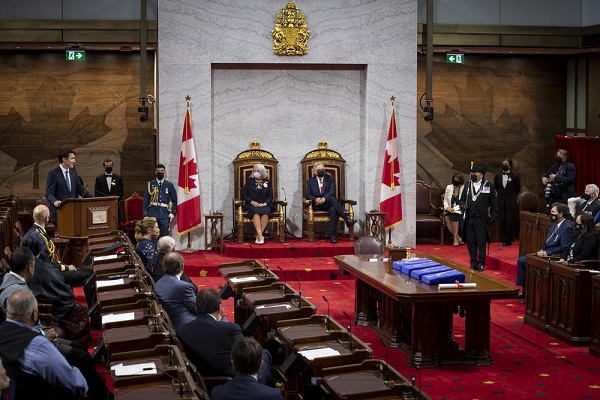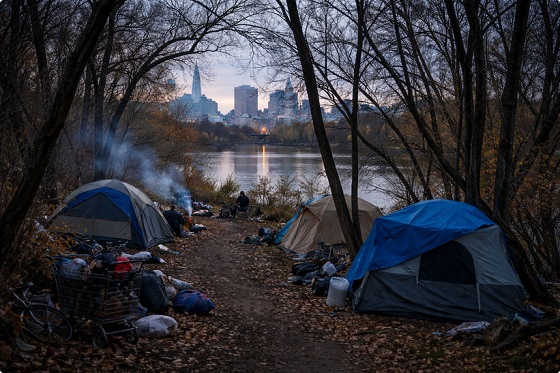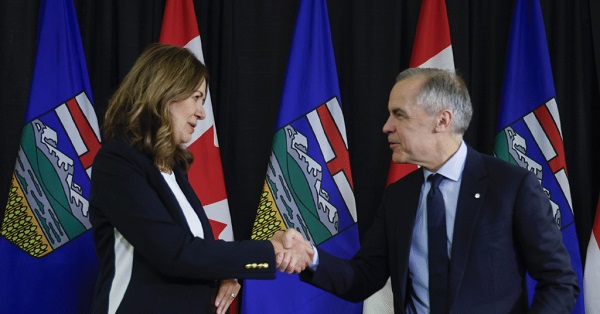Business
Pay increase for Governor General since 2019 is more than average Canadian annual salary

From the Canadian Taxpayers Federation
By Ryan Thorpe
The salary for Canada’s Governor General has skyrocketed by just over $75,000 since 2019. Meanwhile the average annual salary among all full-time workers in Canada was roughly $70,000 in 2024
Governor General Mary Simon pocketed a $15,200 pay raise this year, bumping her annual salary for 2025 up to $378,000.
This marks Simon’s fourth pay raise since she was appointed governor general in 2021, meaning she now makes $49,300 more than when she took on the role.
“Can anyone in government explain how Canadians are getting more value from the governor general, because her taxpayer-funded salary just increased by more than $1,200 a month,” said Franco Terrazzano, CTF Federal Director. “The automatic-pay-raise culture in Ottawa is ridiculous and politicians and bureaucrats shouldn’t expect more money every year just because they’re on the taxpayer payroll.”
The Canadian Taxpayers Federation confirmed Simon’s current salary and the details of her latest pay raise with the Privy Council Office.
“For 2025, the Governor General’s salary, which is determined in accordance with the provisions of the Governor General’s Act … is $378,000,” a PCO spokesperson told the CTF.
The federal government hiked the governor general’s annual salary by $75,200 (or 25 per cent) since 2019.
Meanwhile, the average annual salary among all full-time workers in Canada was roughly $70,000 in 2024, according to Statistics Canada data.
“Canadians can’t afford to keep paying more for a largely symbolic role,” Terrazzano said. “The governor general already takes a huge taxpayer-funded salary and she should show leadership by refusing this year’s pay hike.”
On top of the $378,000 annual salary, the governor general receives a range of lucrative perks, including a taxpayer-funded mansion, a platinum pension, a clothing budget, paid dry cleaning services and lavish travel expenses.
Former governors general are eligible for a full pension, of about $150,000 a year, regardless of how long they serve in office.
Even though Simon’s predecessor, Julie Payette, served in the role for a little more than three years, she will receive an estimated $4.8 million if she collects her pension till the age of 90.
The CTF estimates that Canada’s five former governors general will receive more than $18 million if they collect their pensions until the age of 90.
Even after leaving office, former governors general can also expense taxpayers for up to $206,000 annually for the rest of their lives, continuing up to six months after their deaths.
In May 2023, the National Post reported the governor general can expense up to $130,000 in clothing during their five-year mandates, with a $60,000 cap during the first year.
Simon and Payette combined to expense $88,000 in clothing since 2017, including a velvet dress with silk lining, designer gloves, suits, shoes and scarves, among other items.
Rideau Hall expensed $117,000 in dry-cleaning services since 2018, despite having in-house staff responsible for laundry – an average dry cleaning tab of more than $1,800 per month.
In 2022, Simon’s first full year on the job, she spent $2.7 million on travel, according to government records obtained by the CTF.
Simon’s travel has sparked multiple controversies, including a $100,000 bill for in-flight catering during a weeklong trip to the Middle East, and her $71,000 bill at IceLimo Luxury Travel during a four-day trip to Iceland.
“Platinum pay and perks for the governor general should have been reined in a long time ago,” Terrazzano said. “The government should stop rubberstamping pay raises for the governor general every year, end the expense account for former governors general, reform the platinum pension, scrap the clothing allowance and cut all international travel except for meetings with the monarchy.”
Table: Annual Governor General Salary, per PCO data
|
Year |
GG Salary |
|
2019 |
$302,800 |
|
2020 |
$310,100 |
|
2021 |
$328,700 |
|
2022 |
$342,100 |
|
2023 |
$351,600 |
|
2024 |
$362,800 |
|
2025 |
$378,000 |
Business
Some Of The Wackiest Things Featured In Rand Paul’s New Report Alleging $1,639,135,969,608 In Gov’t Waste


From the Daily Caller News Foundation
Republican Kentucky Sen. Rand Paul released the latest edition of his annual “Festivus” report Tuesday detailing over $1 trillion in alleged wasteful spending in the U.S. government throughout 2025.
The newly released report found an estimated $1,639,135,969,608 total in government waste over the past year. Paul, a prominent fiscal hawk who serves as the chairman of the Senate Homeland Security and Governmental Affairs Committee, said in a statement that “no matter how much taxpayer money Washington burns through, politicians can’t help but demand more.”
“Fiscal responsibility may not be the most crowded road, but it’s one I’ve walked year after year — and this holiday season will be no different,” Paul continued. “So, before we get to the Feats of Strength, it’s time for my Airing of (Spending) Grievances.”
Dear Readers:
As a nonprofit, we are dependent on the generosity of our readers.
Please consider making a small donation of any amount here.
Thank you!
The 2025 “Festivus” report highlighted a spate of instances of wasteful spending from the federal government, including the Department of Health and Human Services (HHS) spent $1.5 million on an “innovative multilevel strategy” to reduce drug use in “Latinx” communities through celebrity influencer campaigns, and also dished out $1.9 million on a “hybrid mobile phone family intervention” aiming to reduce childhood obesity among Latino families living in Los Angeles County.
The report also mentions that HHS spent more than $40 million on influencers to promote getting vaccinated against COVID-19 for racial and ethnic minority groups.
The State Department doled out $244,252 to Stand for Peace in Islamabad to produce a television cartoon series that teaches children in Pakistan how to combat climate change and also spent $1.5 million to promote American films, television shows and video games abroad, according to the report.
The Department of Veterans Affairs (VA) spent more than $1,079,360 teaching teenage ferrets to binge drink alcohol this year, according to Paul’s report.
The report found that the National Science Foundation (NSF) shelled out $497,200 on a “Video Game Challenge” for kids. The NSF and other federal agencies also paid $14,643,280 to make monkeys play a video game in the style of the “Price Is Right,” the report states.
Paul’s 2024 “Festivus” report similarly featured several instances of wasteful federal government spending, such as a Las Vegas pickleball complex and a cabaret show on ice.
The Trump administration has been attempting to uproot wasteful government spending and reduce the federal workforce this year. The administration’s cuts have shrunk the federal workforce to the smallest level in more than a decade, according to recent economic data.
Festivus is a humorous holiday observed annually on Dec. 23, dating back to a popular 1997 episode of the sitcom “Seinfeld.” Observance of the holiday notably includes an “airing of grievances,” per the “Seinfeld” episode of its origin.
Alberta
A Christmas wish list for health-care reform

From the Fraser Institute
By Nadeem Esmail and Mackenzie Moir
It’s an exciting time in Canadian health-care policy. But even the slew of new reforms in Alberta only go part of the way to using all the policy tools employed by high performing universal health-care systems.
For 2026, for the sake of Canadian patients, let’s hope Alberta stays the path on changes to how hospitals are paid and allowing some private purchases of health care, and that other provinces start to catch up.
While Alberta’s new reforms were welcome news this year, it’s clear Canada’s health-care system continued to struggle. Canadians were reminded by our annual comparison of health care systems that they pay for one of the developed world’s most expensive universal health-care systems, yet have some of the fewest physicians and hospital beds, while waiting in some of the longest queues.
And speaking of queues, wait times across Canada for non-emergency care reached the second-highest level ever measured at 28.6 weeks from general practitioner referral to actual treatment. That’s more than triple the wait of the early 1990s despite decades of government promises and spending commitments. Other work found that at least 23,746 patients died while waiting for care, and nearly 1.3 million Canadians left our overcrowded emergency rooms without being treated.
At least one province has shown a genuine willingness to do something about these problems.
The Smith government in Alberta announced early in the year that it would move towards paying hospitals per-patient treated as opposed to a fixed annual budget, a policy approach that Quebec has been working on for years. Albertans will also soon be able purchase, at least in a limited way, some diagnostic and surgical services for themselves, which is again already possible in Quebec. Alberta has also gone a step further by allowing physicians to work in both public and private settings.
While controversial in Canada, these approaches simply mirror what is being done in all of the developed world’s top-performing universal health-care systems. Australia, the Netherlands, Germany and Switzerland all pay their hospitals per patient treated, and allow patients the opportunity to purchase care privately if they wish. They all also have better and faster universally accessible health care than Canada’s provinces provide, while spending a little more (Switzerland) or less (Australia, Germany, the Netherlands) than we do.
While these reforms are clearly a step in the right direction, there’s more to be done.
Even if we include Alberta’s reforms, these countries still do some very important things differently.
Critically, all of these countries expect patients to pay a small amount for their universally accessible services. The reasoning is straightforward: we all spend our own money more carefully than we spend someone else’s, and patients will make more informed decisions about when and where it’s best to access the health-care system when they have to pay a little out of pocket.
The evidence around this policy is clear—with appropriate safeguards to protect the very ill and exemptions for lower-income and other vulnerable populations, the demand for outpatient healthcare services falls, reducing delays and freeing up resources for others.
Charging patients even small amounts for care would of course violate the Canada Health Act, but it would also emulate the approach of 100 per cent of the developed world’s top-performing health-care systems. In this case, violating outdated federal policy means better universal health care for Canadians.
These top-performing countries also see the private sector and innovative entrepreneurs as partners in delivering universal health care. A relationship that is far different from the limited individual contracts some provinces have with private clinics and surgical centres to provide care in Canada. In these other countries, even full-service hospitals are operated by private providers. Importantly, partnering with innovative private providers, even hospitals, to deliver universal health care does not violate the Canada Health Act.
So, while Alberta has made strides this past year moving towards the well-established higher performance policy approach followed elsewhere, the Smith government remains at least a couple steps short of truly adopting a more Australian or European approach for health care. And other provinces have yet to even get to where Alberta will soon be.
Let’s hope in 2026 that Alberta keeps moving towards a truly world class universal health-care experience for patients, and that the other provinces catch up.
-

 Energy2 days ago
Energy2 days agoThe Top News Stories That Shaped Canadian Energy in 2025 and Will Continue to Shape Canadian Energy in 2026
-

 International2 days ago
International2 days ago$2.6 million raised for man who wrestled shotgun from Bondi Beach terrorist
-

 Frontier Centre for Public Policy15 hours ago
Frontier Centre for Public Policy15 hours agoTent Cities Were Rare Five Years Ago. Now They’re Everywhere
-

 Alberta2 days ago
Alberta2 days agoOttawa-Alberta agreement may produce oligopoly in the oilsands
-

 Energy2 days ago
Energy2 days ago‘The electric story is over’
-

 Opinion16 hours ago
Opinion16 hours agoPope Leo XIV’s Christmas night homily
-

 Energy2 days ago
Energy2 days agoWestern Canada’s supply chain for Santa Claus
-

 armed forces16 hours ago
armed forces16 hours agoRemembering Afghanistan and the sacrifices of our military families



